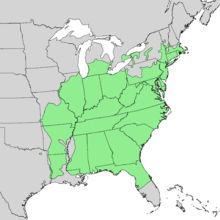Pignut hickory
| Pignut hickory | |
|---|---|
 |
|
| Scientific classification | |
| Kingdom: | Plantae |
| (unranked): | Angiosperms |
| (unranked): | Eudicots |
| (unranked): | Rosids |
| Order: | Fagales |
| Family: | Juglandaceae |
| Genus: | Carya |
| Species: | C. glabra |
| Binomial name | |
|
Carya glabra Miller |
|
 |
|
| Natural range of Carya glabra | |
Carya glabra, the pignut hickory, is a common, but not abundant species of hickory in the oak-hickory forest association in the Eastern United States and Canada. Other common names are pignut, sweet pignut, coast pignut hickory, smoothbark hickory, swamp hickory, and broom hickory. The pear-shaped nut ripens in September and October and is an important part of the diet of many wild animals. The wood is used for a variety of products, including fuel for home heating.
The range of pignut hickory covers nearly all of eastern United States (11). The species grows in central Florida and westward through Louisiana and along the Gulf Coast to Alabama through Mississippi. It extends through parts of East Texas to Louisiana, Arkansas, Missouri and extreme southeastern Iowa. Its range further includes Massachusetts and the southwest corner of New Hampshire westward through southern Vermont to central Lower Peninsula of Michigan and Illinois.
The best development of this species is in the lower Ohio River Basin. It prevails over other species of hickory in the Appalachian forests. Pignut makes up much of the hickory harvested in Kentucky, West Virginia, the Cumberland Mountains of Tennessee, and the hill country of the Ohio Valley.
...
Wikipedia
